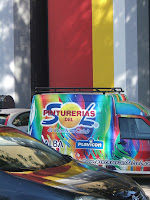I was asked recently when on this trip I had particularly felt I was somewhere else. Well, running, last Friday.
It was a gray, cold, drizzly morning with a strong wind, easily run-in-a-fleece weather; a day worthy of Michigan at the end of March (remember, we just celebrated the first day of spring). The wind was stronger by the river, and stronger yet as I turned back and realized I had had it behind me; the rain stung my face and my ears. The river looked brown, as usual, but high and choppy.
Then I saw a tero. Two, actually. I recognized them by appearance, not by name (those who know me can testify I'm no ornithologist), and I recognized their appearance because I'd been looking at photographs.
When I first read the sentence in the book I'm translating --he looked like a tero-- I had no idea. It could have been anything: a kind of rodent, a local bogeyman, an aristocratic dandy. It took some dictionary rummaging, a trail from a more local name to a more general name to a comparison of photographs to settle on the English. Tero to Teruteru to Southern Lapwing.
It was bumpy ground, rough grass and not-quite-park just where the construction site started. The two men I usually see practicing Tai Chi (always on the danger side of the keep-back sign meant to protect the unwary from the eroding bluffs) were posed in the distance. I was pulling my cold hands further into my sleeves when the dark, trailing crest at the back of a bird's head caught my eye. And I thought, I really am somewhere else now.
 |
| [photo via Wikipedia] |
Does it help the translation? Change it?
It did push me toward using the local name, not the English name of the bird. Wikipedia will tell you about the Tero in Spanish or the Southern Lapwing in English. Lapwing now seems too domesticating (and, perhaps contradictorily, needlessly distancing; the reader who doesn't know her birds won't know a southern lapwing from a cedar waxwing). Also, to me, lapwing sounds somehow more fluid in its movements, not poking and jumping on the ground like the birds I saw, longish-legged and knobby-kneed, like miniature heron relations. But will the reader know a tero is a bird if I don't add other pointers?
It's still a work-in-progress. For now, I've got both names in the draft.
































